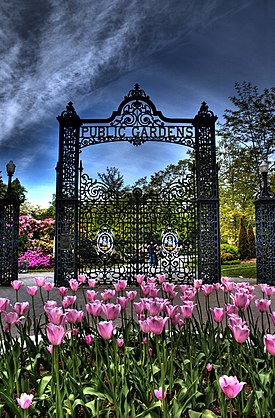Halifax Public Gardens
| Halifax Public Gardens | |
|---|---|

Wrought-iron gates erected to honour the Halifax Provisional Battalion (1907)
|
|
| Type | Public park |
| Location | Halifax, Nova Scotia |
| Area | 16 Acres |
| Created | 1867 |
| Operated by | Halifax Regional Municipality |
| Official name | Halifax Public Gardens National Historic Site of Canada |
| Designated | 1984 |
| Type | Municipally Registered Property |
| Designated | 1991 |
The Halifax Public Gardens are Victorian era public gardens formally established in 1867, the year of Canadian Confederation. The gardens are located in the Halifax Regional Municipality, Nova Scotia on the Halifax Peninsula near the popular shopping district of Spring Garden Road and opposite Victoria Park. The gardens were designated a National Historic Site of Canada in 1984.
The Public Gardens encompass 16 acres and are bounded by Spring Garden Road, South Park Street, Summer Street and Sackville Street. They are open annually from approximately May 1 until November 1. The landscaping style is Victorian formal and provides a popular setting for wedding and prom photos. In addition to statues and extensive flower beds, there are three fountains, two stone bridges, three ponds (one large and two small), and a small concession building (located in the original Horticultural Hall). The gardens also feature a bandstand that is used for free public concerts on Sunday afternoons during the summer. There are celebrations in the gardens every year on Canada day (July 1) and Natal Day (the first Monday in August).
In the past, many people enjoyed feeding the ducks who make the gardens their home, although it is now prohibited.
The Public Gardens were badly damaged by Hurricane Juan in 2003. Many trees were destroyed, necessitating the early closure of the gardens and some redesign. The gardens reopened on Canada Day, 2004 after a restoration aided in part by $1 million which was raised during a radio telethon.
The Halifax Public Gardens was established in 1874 by the amalgamation of two older gardens, the Nova Scotia Horticultural Society Garden (laid out in 1837) and an adjacent public park (opened in 1866). In 1872, Richard Power was hired as the park’s superintendent. He introduced an axially symmetrical plan which governs the overall design of the site. Over the years, he oversaw the introduction of the bandstand (designed by architect Henry Busch), fountains, statues, and wrought iron gates as well as establishing the bedding out of annuals in highly designed carpet beds, redesigned Griffin’s Pond and introduced water fowl.
...
Wikipedia
